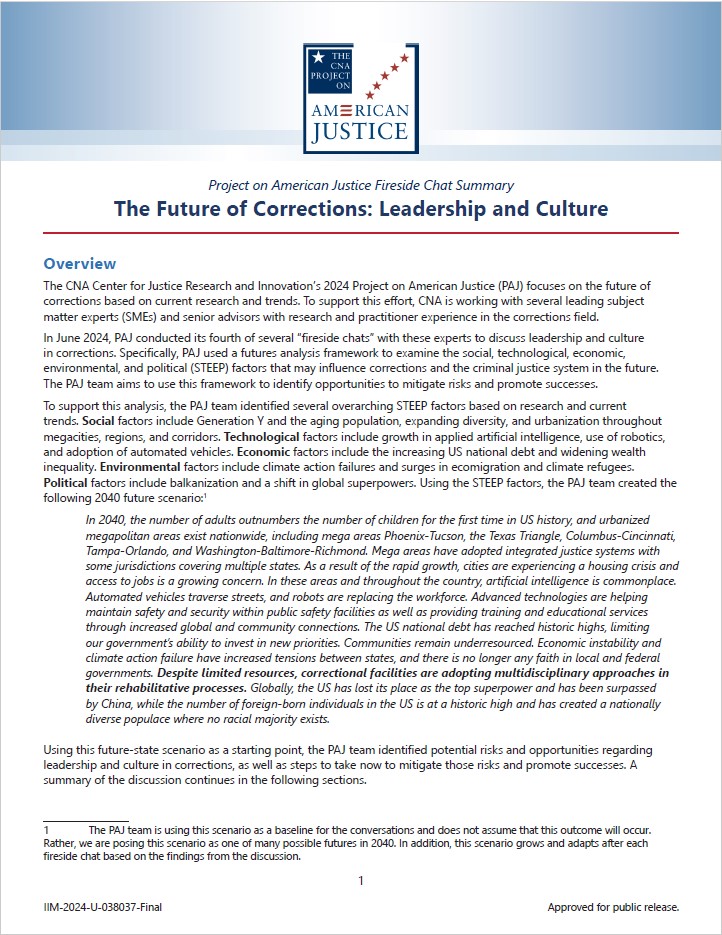Overview
The CNA Center for Justice Research and Innovation’s 2024 Project on American Justice (PAJ) focuses on the future of corrections based on current research and trends. To support this effort, CNA is working with several leading subject matter experts (SMEs) and senior advisors with research and practitioner experience in the corrections field.
In June 2024, PAJ conducted its fourth of several “fireside chats” with these experts to discuss leadership and culture in corrections. Specifically, PAJ used a futures analysis framework to examine the social, technological, economic, environmental, and political (STEEP) factors that may influence corrections and the criminal justice system in the future. The PAJ team aims to use this framework to identify opportunities to mitigate risks and promote successes.
To support this analysis, the PAJ team identified several overarching STEEP factors based on research and current trends. Social factors include Generation Y and the aging population; urbanization throughout megacities, regions, and corridors; and expanding diversity. Technological factors include growth in applied artificial intelligence (AI), use of robotics, and adoption of automated vehicles. Economic factors include the increasing US national debt and widening wealth inequality. Environmental factors include climate action failures and surges in ecomigration and climate refugees. Political factors include balkanization and a shift in global superpowers. Using the STEEP factors, the PAJ team created the following 2040 future scenario:
In 2040, the number of adults outnumbers the number of children for the first time in US history, and urbanized megapolitan areas exist nationwide, including mega areas Phoenix-Tucson, the Texas Triangle, Columbus-Cincinnati, Tampa-Orlando, and Washington-Baltimore-Richmond. Mega areas have adopted integrated justice systems with some jurisdictions covering multiple states. As a result of the rapid growth, cities are experiencing a housing crisis and access to jobs is a growing concern. In these areas and throughout the country, artificial intelligence is commonplace. Automated vehicles traverse streets, and robots are replacing the workforce. Advanced technologies are helping maintain safety and security within public safety facilities as well as providing training and educational services through increased global and community connections. The US national debt has reached historic highs, limiting our government’s ability to invest in new priorities. Communities remain underresourced. Economic instability and climate action failure have increased tensions between states, and there is no longer any faith in local and federal governments. Despite limited resources, correctional facilities are adopting multidisciplinary approaches in their rehabilitative processes. Globally, the US has lost its place as the top superpower and has been surpassed by China, while the number of foreign-born individuals in the US is at a historic high and has created a nationally diverse populace where no racial majority exists.
Using this future-state scenario as a starting point, the PAJ team identified potential risks and opportunities regarding civilianization in corrections, as well as steps to take now to mitigate those risks and promote successes. A summary of the discussion continues in the following sections.
Download reportDetails
- Pages:
- Document Number:
- Publication Date: 5/13/2025
